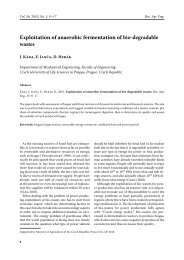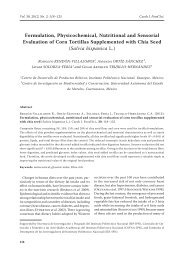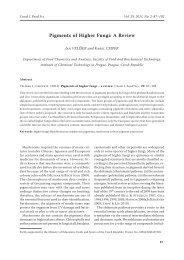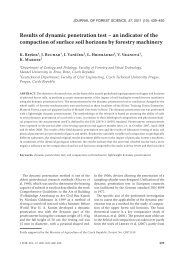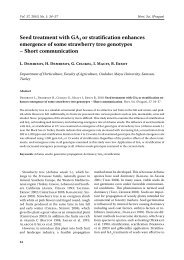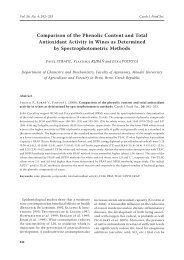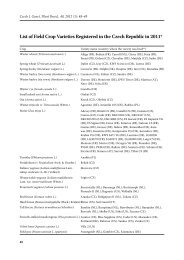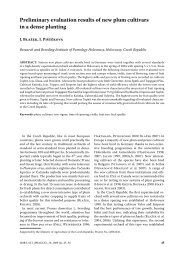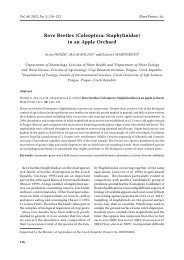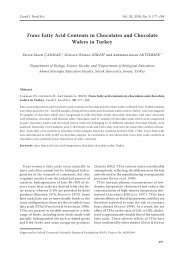The Viral Etiology of Tomato Yellow Leaf Curl Disease – A Review
The Viral Etiology of Tomato Yellow Leaf Curl Disease – A Review
The Viral Etiology of Tomato Yellow Leaf Curl Disease – A Review
Create successful ePaper yourself
Turn your PDF publications into a flip-book with our unique Google optimized e-Paper software.
Plant Protect. Sci. Vol. 45, 2009, No. 3: 81<strong>–</strong>97<br />
nuclear shuttle for NLS-bearing proteins) because<br />
<strong>of</strong> its NLS. To examine this hypothesis, a tomato<br />
karyopherin α homologue had to be identified. To<br />
this end, my group first isolated a tomato cDNA<br />
clone encoding this protein, LeKAPα1. Next, the<br />
interaction <strong>of</strong> LeKAPα1 with TYLCV CP was<br />
demonstrated in a yeast two-hybrid system (Kunik<br />
et al. 1999). <strong>The</strong> results indicated that LeKAPα1<br />
specifically interacts with CP, most likely mediating<br />
its nuclear import by a karyopherin α-dependent<br />
mechanism. For the TYLCV CP to be considered<br />
a nuclear shuttle protein for the viral genome, another<br />
prerequisite, namely ssDNA-binding activity,<br />
had to be met. This activity was demonstrated by<br />
gel-shift assay (Palanichelvam et al. 1998).<br />
Upon entry into the nucleus, geminiviruses<br />
replicate, producing both single-stranded and<br />
double-stranded forms <strong>of</strong> the viral genome. Once<br />
viral DNA has begun to replicate in the nucleus,<br />
the newly synthesised CP carries out at least two<br />
distinct functions: (i) nuclear export <strong>of</strong> the infectious<br />
form <strong>of</strong> the virus, and (ii) encapsidation <strong>of</strong><br />
ssDNA into virions. However, to move from cell<br />
to cell, the infectious form <strong>of</strong> the virus must be<br />
able to leave the plant-cell nucleus and be transported<br />
to the plasmodesmata, and through them<br />
to adjacent cells, followed by transport to and<br />
entry into the nucleus <strong>of</strong> these neighboring cells.<br />
A functional analysis aimed at characterizing the<br />
proteins involved in the intracellular movement<br />
<strong>of</strong> TYLCV showed that the CP, together with two<br />
other proteins, V2 and C4, are involved in the delivery<br />
<strong>of</strong> viral DNA, as virions or as nucleoprotein<br />
complexes, to the plant-cell periphery (Rojas<br />
et al. 2001). To be transported to adjacent cells,<br />
the virus must overcome the barrier to cell-tocell<br />
movement presented by the cell wall. To this<br />
end, plant viruses encode movement proteins<br />
(MPs) that can interact with plasmodesmata, the<br />
plasma-membrane-lined channels that interconnect<br />
plant cells, to facilitate cell-to-cell transport<br />
<strong>of</strong> the infectious form <strong>of</strong> the virus (Heinlein &<br />
Epel 2004; Lucas & Lee 2004; Ruiz-Medrano<br />
et al. 2004). Rojas et al. (2001) suggested that it<br />
is the C4 protein, through a putative N-terminal<br />
myristoylation domain, which acts to deliver the<br />
viral DNA to plasmodesmata and to mediate cellto-cell<br />
transport into neighboring, uninfected<br />
cells.<br />
Base on recent accumulated data, a model for<br />
geminivirus intra- and intercellular movement was<br />
suggested by Gafni and Epel (2002), in which the<br />
movement <strong>of</strong> monopartite geminiviruses, including<br />
TYLCV, is strictly dependent on the viral CP.<br />
8. Methods to control the disease<br />
Several methods have been developed to control<br />
TYLCD, such as the use <strong>of</strong> healthy transplants,<br />
chemical and physical control <strong>of</strong> the vector, crop<br />
rotation, and breeding for resistance to TYLCV<br />
(Nakhla & Maxwell 1998). <strong>The</strong> most effective<br />
and environmentally sound management remains<br />
planting resistant or tolerant lines. Thus, breeding<br />
for TYLCV resistance is probably the most important<br />
long term goal for lasting TYLCV management.<br />
At present, only partially resistant Fl hybrids are<br />
commercially available. Moreover, a prevalent<br />
problem is associated with the definition <strong>of</strong> resistance.<br />
As stated by Lapidot and Friedmann<br />
(2002), a host plant is resistant to TYLCV if it<br />
can suppress its multiplication and consequently<br />
suppress the development <strong>of</strong> disease symptoms.<br />
Lower virus accumulation in a resistant host has<br />
been associated with the latter’s resistance, as well<br />
as with the effect <strong>of</strong> infection on total yield and<br />
yield components (Lapidot et al. 1997). Classical<br />
breeding has attempted to introduce TYLCV<br />
resistance in tomato cultivars. However, resistance<br />
appears to be controlled by one to five genes and<br />
crosses have produced only tolerant hybrids. It is<br />
unfortunate that after over 25 years <strong>of</strong> breeding<br />
programs, the best commercially available cultivars<br />
show only tolerance to the virus and meanwhile,<br />
the disease continues to spread. <strong>The</strong>refore, the<br />
production <strong>of</strong> transgenic tomato plants appears to<br />
be a more promising way <strong>of</strong> obtaining resistance<br />
to TYLCV. Several strategies have been used to<br />
engineer plants resistant to viral pathogens, based<br />
on the concept that the introduction and expression<br />
<strong>of</strong> viral sequences in plants can interfere with<br />
the virus’s life cycle. This strategy is also referred<br />
to as pathogen derived resistance.<br />
8.1. Breeding for resistance<br />
Breeding for resistance in cultivated tomato<br />
varieties is the best approach to controlling viral<br />
disease (Lapidot et al. 1997; Polston & Anderson<br />
1997; Lapidot & Friedmann 2002).<br />
Genetic resistance or tolerance to TYLCV has<br />
been introgressed in tomato in order to develop<br />
resistant cultivars since the early 1970s, and some<br />
89




